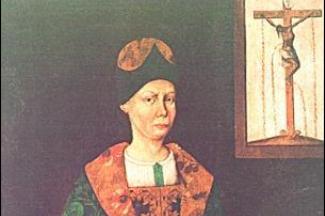
December 2, 2013, by Harry Cocks
Maria-Magdalena Mazepa: Politics and Sorcery in Ukraine
Current street protests in Ukraine about whether to pursue an EU integration pact or forge closer links with Russia are part of a long history of tension and accommodation between the two countries. The Ukrainian dilemma (East or West, Europe or Russia) is the background to a new article for Russian History from Liudmyla Sharipova of Nottingham’s History department.
Maria-Magdalena Mazepa (c. 1617-1707, pictured), the subject of the piece, was the natural mother of Ivan Mazepa (1639-1709), ruler (or Hetman) of Ukraine between 1687 and 1708. He is perhaps best known for his attempt to remove the Russian stranglehold over Ukraine by defecting to the Swedes in the run-up to the battle of Poltava (1709), the key encounter of Tsar Peter I’s Great Northern War (1700-1721). Though unsuccessful, Ivan’s attempted secession resulted in a wave of retribution and further strengthened Ukraine’s fatal bond with the Russian Empire. Ever since the eighteenth century, historians have clashed over Mazepa’s actions: was he a traitor to “Great Russia” or a failed saviour of his own nation? Predictably, these assessments tend to be emotionally charged, and fall into two broad categories: outright condemnation by the “imperial” side – including Soviet Marxist and contemporary Russian authors – and adulation on the part of Ukrainian nationalist and post-colonial historians. In her article, Dr Sharipova tries to find some middle ground by looking at the hetman’s mother Maria-Magdalena Mazepa, a proud and ambitious woman, holder of two convent headships and eager dabbler in politics.
Born Maryna Mokievska and widowed in 1665, Mazepa took the veil in an elite women’s convent in Kyiv under the monastic name of Maria-Magdalena. On becoming mother superior in the early 1680s, she played a prominent role as her son’s informal political aide and confidante from the start of his rule in 1687 until her death in 1707. Her forceful personality and willingness to engage with the power struggles in the Hetmanate (the Ukrainian lands along the eastern bank of the Dnieper River with the city of Kyiv, which Muscovy annexed from Poland-Lithuania in the second half of the 17th century) provoked social resentment, which culminated in a formally recorded witchcraft accusation.
The charges were based on suspicion of the Mazepas’ closeness to the Tsar and his family (a rapport had famously existed between Tsar Peter and Ivan Mazepa, and on a visit to Moscow in 1687, Maria-Magdalena was lavishly entertained at the Russian royal court), and widespread fear in the East Slavic societies of powerful women. Like witches, such women were regarded as dangerously subverting the “natural” order that precluded female access to positions of authority. It was widely believed that political and public offices could only be held by men, who had a natural and God-given right to the exercise of power. Although Maria-Magdalena’s position as the hetman’s mother put her beyond the reach of those members of the Ukrainian Cossack elite who would have liked to put her back in her place as a mere woman, unfriendly rumours were spread. For example, it was said that an icon discovered in a humble village near Chernihiv, where it had worked miracles, immediately lost its supernatural powers on being placed in Maria-Magdalena’s convent in Kyiv. However, her detractors were on safer ground in attacking her political influence, as she provided quiet but significant behind-the-scenes assistance to her son. When Ivan Mazepa began to make plans to take Ukraine away from Russia’s increasingly claustrophobic embrace, he entrusted his mother with the safe-keeping of the secret diplomatic correspondence with the foreign powers that were involved in the plot. On her deathbed Maria-Magdalena took care of the explosive documentation by passing it on to Ivan’s associates. She was fortunate not to live long enough to see her son’s dramatic downfall that occurred just a year later.
By placing Maria-Magdalena Mazepa within her cultural and political context we can see the charge of sorcery against her as part of an undercover campaign waged by the envious Cossack elite. They aimed to both neutralise her perceived spiritual power, and to remove a key obstacle to their political ambitions.
‘Earthly Mother, Holy Witch: Social Perceptions of Maria-Magdalena Mazepa (1687-1707)’, Russian History, 40:3-4 (2013) 451–468: http://booksandjournals.brillonline.com/content/journals/10.1163/18763316-04004011
No comments yet, fill out a comment to be the first

Leave a Reply